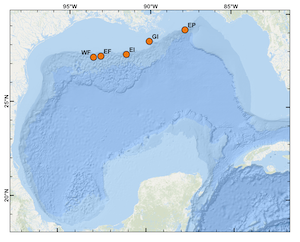NOAA SEFSC Gulf of Mexico Moored Passive Acoustic Studies
This record represents raw passive acoustic data collected by NOAA's Southeast Fisheries
Science Center (SEFSC) from moored recording instruments in the Gulf of Mexico since
2016. Moored acoustic recording instruments used in these studies include High-frequency
Acoustic Recording Packages (HARPs), developed and deployed by Scripps Institution
of Oceanography on behalf of NOAA SEFSC, and Soundtrap long-term recorders. These
recording instruments continuously record sound across a range of frequencies for
use in studies of vocally-active cetaceans, fish species, and anthropogenic sound
sources, and for characterizing the Gulf of Mexico soundscape. Study design and goals
varied among deployments; the focus of many deployments was to understand the spatiotemporal
distribution of the endangered Rice's whale. Raw acoustic recordings may be in wav,
xwav, or flac format, depending on recording instrument and sample rate. In addition
to the raw acoustic recordings, there may be several associated files for these data,
which include calibration files (transfer functions) and Long-Term Spectral Averages
(LTSAs) for sound exploration and accessibility. Three readme files provide details
on the acoustic recording's xwav format, LTSA format, and transfer function descriptions,
when appropriate. All recordings are collected in UTC.
- Cite as: NOAA Fisheries Southeast Fisheries Science Center. 2022. NOAA SEFSC Gulf of Mexico Moored Passive Acoustic Studies Raw Passive Acoustic Data. NOAA National Centers for Environmental Information. https://doi.org/10.25921/4SGC-2N83 [access date].
- 10.25921/4SGC-2N83
- NCEI Metadata ID: gov.noaa.ncei.pad:SEFSC_GOM_Moored_Raw_Data
gov.noaa.ncei.pad:SEFSC_GOM_Moored_Raw_Data
| Search Data |
|
| Download Data |
|
| Distribution Formats |
|
| Ordering Instructions | Contact NCEI for other distribution options and instructions. |
| Distributor | NOAA National Centers for Environmental Information ncei.info@noaa.gov |
| Dataset Point of Contact | NOAA National Centers for Environmental Information ncei.info@noaa.gov |
| Dataset Point of Contact | Carrie Wall NCEI Passive Acoustic Archive Lead NOAA National Centers for Environmental Information pad.info@noaa.gov |
| Time Period | 2016-07-19T18:00:00 to 2017-08-13T12:10:00 |
| Spatial Bounding Box Coordinates |
West:-93.3941
East:-87.8583
South:27.6541
North:29.2811
|
| Spatial Coverage Map | |
| General Documentation | |
| Associated Resources |
|
| Publication Dates |
|
| Dataset Progress Status | Ongoing - data is continually being updated |
| Data Update Frequency | As needed |
| Purpose | The Gulf of Mexico oceanic waters are home to twenty cetacean species, including the endangered Rice's whale. These waters are also highly industrialized, with sound-producing human activities including shipping, oil and gas exploration and extraction, fishing, and military activities. The National Marine Fisheries Service (NMFS) is responsible for studying the populations of whales and dolphins within the U.S. EEZ waters of the Southeast Region. A variety of information is needed in order to properly manage human effects on these populations and protect them from current or future depletion. Passive acoustics are useful for assessing temporal and spatial changes in the occurrence, density, and behavior of some animals, for augmenting visual surveys, and can provide important details regarding the acoustic environments that cetaceans live in. The purpose of these passive acoustic mooring deployments is to collect acoustic recordings to assess presence and distribution of marine mammals in the Gulf of Mexico and to assess variability in soundscapes and anthropogenic noise sources over space and time. |
| Dataset Citation |
|
| Cited Authors |
|
| Principal Investigators |
|
| Collaborators |
|
| Publishers |
|
| Acknowledgments |
|
| Theme keywords | Global Change Master Directory (GCMD) Science Keywords
|
| Data Center keywords | Global Change Master Directory (GCMD) Data Center Keywords
|
| Platform keywords | Global Change Master Directory (GCMD) Platform Keywords
|
| Instrument keywords | Global Change Master Directory (GCMD) Instrument Keywords
|
| Place keywords | Global Change Master Directory (GCMD) Location Keywords
|
| Project keywords | Global Change Master Directory (GCMD) Project Keywords
|
| Use Constraints |
|
| Access Constraints |
|
| Other Constraints | Cite as: NOAA Fisheries Southeast Fisheries Science Center. 2022. NOAA SEFSC Gulf of Mexico Moored Passive Acoustic Studies Raw Passive Acoustic Data. NOAA National Centers for Environmental Information. https://doi.org/10.25921/4SGC-2N83 [access date]. |
| Fees |
|
| Processing Steps |
|
| Instrument |
|
| Platform |
|
Last Modified: 2023-08-31T20:37:14
For questions about the information on this page, please email:ncei.info@noaa.gov
